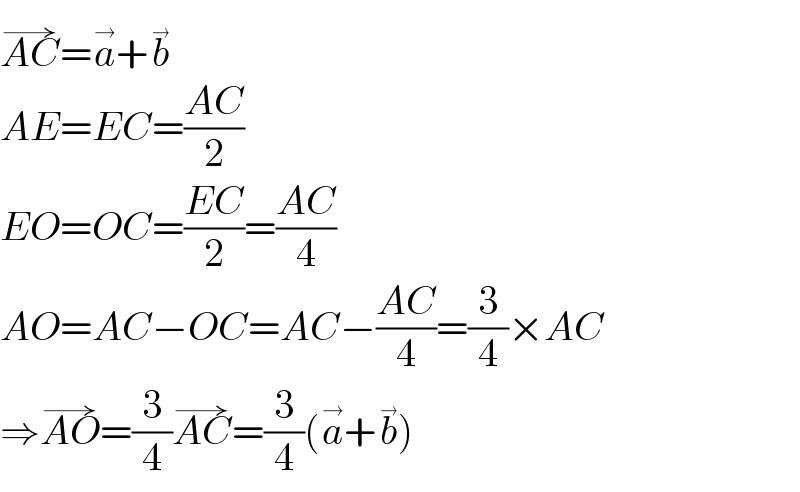Question Number 168801 by Ari last updated on 17/Apr/22

Commented by cortano1 last updated on 18/Apr/22

$$\overset{\rightarrow} {{AO}}\:=\:\frac{\mathrm{2}}{\mathrm{3}}\overset{\rightarrow} {{AC}}\:=\:\frac{\mathrm{4}}{\mathrm{3}}\left(\overset{\rightarrow} {{a}}+\overset{\rightarrow} {{b}}\right) \\ $$
Commented by mr W last updated on 18/Apr/22

$$\overset{\rightarrow} {{AO}}\:=\:\frac{\mathrm{3}}{\mathrm{4}}\overset{\rightarrow} {{AC}}\:=\:\frac{\mathrm{3}}{\mathrm{4}}\left(\overset{\rightarrow} {{a}}+\overset{\rightarrow} {{b}}\right) \\ $$
Commented by Ari last updated on 18/Apr/22

$$\overset{\rightarrow} {{A}O}=\frac{\mathrm{2}}{\mathrm{3}}\left(\overset{\rightarrow} {{a}}+\overset{\rightarrow} {{b}}\right) \\ $$
Commented by mr W last updated on 18/Apr/22

Commented by mr W last updated on 18/Apr/22

$$\overset{\rightarrow} {{AC}}=\overset{\rightarrow} {{a}}+\overset{\rightarrow} {{b}} \\ $$$${AE}={EC}=\frac{{AC}}{\mathrm{2}} \\ $$$${EO}={OC}=\frac{{EC}}{\mathrm{2}}=\frac{{AC}}{\mathrm{4}} \\ $$$${AO}={AC}−{OC}={AC}−\frac{{AC}}{\mathrm{4}}=\frac{\mathrm{3}}{\mathrm{4}}×{AC} \\ $$$$\Rightarrow\overset{\rightarrow} {{AO}}=\frac{\mathrm{3}}{\mathrm{4}}\overset{\rightarrow} {{AC}}=\frac{\mathrm{3}}{\mathrm{4}}\left(\overset{\rightarrow} {{a}}+\overset{\rightarrow} {{b}}\right) \\ $$
Commented by Ari last updated on 18/Apr/22
Yes Mr.You are right!
